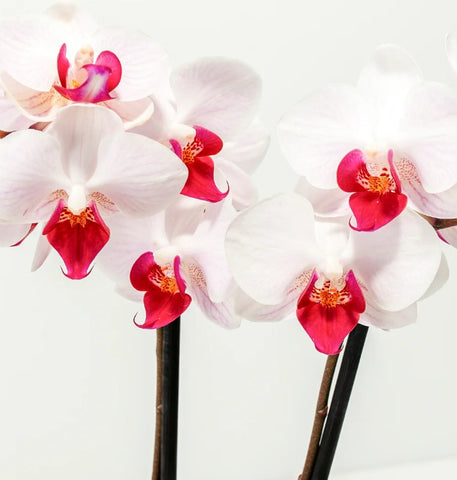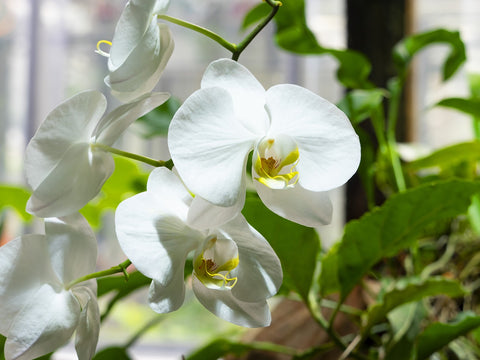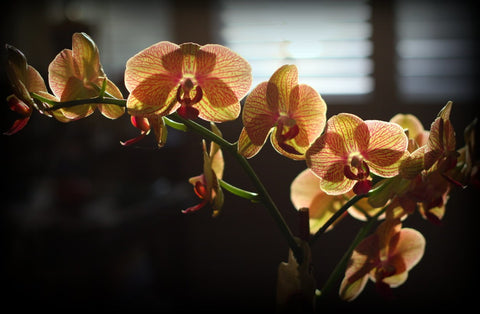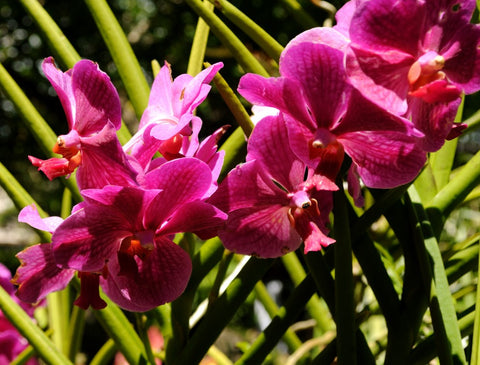Gift Card Balance
Enter the code below to redeem your gift card

Orchids make ideal indoor plants with their delicate, colorful, and fragrant blooms. While they enjoy a reputation for being low-maintenance plants, mastering their care can be tricky, especially in terms of meeting their sunlight requirements.
Natural sunlight is a source of energy for all plants, including orchids; it's vital for their growth, blooming, and overall health. However, too much or too little sunlight can harm these gorgeous flowering plants.
So, how much light do orchids need?
In this comprehensive guide, you will learn about orchids' light requirements, ensuring they thrive and beautify your space with their enchanting presence, divine aroma, and amazing colors.

Orchids (Orchidaceae) are some of the most popular houseplants with over 28,000 species across 763 genera. Despite their delicate appearance, many orchid varieties are surprisingly resilient and easy to grow, requiring minimal care to thrive.
With proper attention to light, water, and temperature, these blooming wonders can flower for several weeks or months, bringing a visual interest and aromatic pleasure into your home, and rewarding your senses every time.
Renowned for their exotic allure, orchids symbolize love, purity, thoughtfulness, and beauty. As the most popular cut flower globally, they are a much-appreciated gift at various occasions, such as weddings, birthdays, and other special events. They add a touch of sophistication and elegance to any interior space.

Orchids need bright, indirect light to thrive and enhance their flowering potential indoors and outdoors. Generally, at least 6 hours of sunlight is recommended for orchids, irrespective of their variety. Incorrect light exposure can result in various issues, including fewer blooms or stunted growth.
Orchids typically need blue light to grow and red light to produce flowers. Furthermore, orchid varieties are classified into three groups, based on the type of light they require (measured in foot candles.) There are full-sun orchids (3000-foot candles), which prefer direct sunlight. Medium-light orchids (2000-foot candles), such as Oncidium orchids, thrive in bright, indirect light. Low-light orchids (1000-1500-foot candles) do well in dappled sunlight.
So, you need to know what orchid variety you have to provide it with the right light conditions.
Orchids, which like direct sunlight include Cymbidium orchids, Cattleya orchids, Vanda orchids, and Dendrobium orchids. These beauties need at least 6 hours of full sun to flourish and produce exquisite blooms.
Not all, but some orchid varieties can grow in lower-light conditions. These include Miltonia orchids (Pansy orchids), Phalaenopsis (Moth orchids), Paphiopedilum (Lady Slipper orchid), and more. Naturally, in the winter, you can safely move your orchid near a window as the sunlight is weaker in the cooler months. Conversely, keep your plants in a spot with subdued light during the summer.

Orchids may experience several issues, due to incorrect sunlight exposure. Seasonal changes also play a role in ensuring that your orchid receives the right kind of light and the correct amount of it. For instance, some relatively low- or medium-light varieties, such as the stunning Miraflore Moth orchid, will benefit from extra light during the winter months, encouraging it to flower.
Your orchid will exhibit the following signs if it isn't getting enough light:
Too much sun for orchid varieties, which prefer indirect sunlight, is a bad idea. It will scorch their delicate leaves and flowers, affecting the plant’s appearance and overall health. Leaf-burned orchids will have brown tips and spots on their foliage. Hence, it’s important to keep your plants away from the summer sun's heat.

Orchids can grow both indoors and outdoors. But it's important to note that most hybrid orchid varieties, like Cymbidium orchids, Dendrobium orchids, and Epidendrum orchids, are only designed to grow outdoors for most of the year.
You can put your orchid outside in the summer, but only if the temperature isn't over 65°F-70°F. This is especially true for delicate orchid varieties like Phalaenopsis, Pleurothallis, Miltonias, and Paphiopedilums.
You may benefit from the following orchid summer care tips:
Yellowing leaves, premature loss of foliage, sunburn, and shriveled pseudobulbs are the signs of orchids getting too hot. Hydrate your orchid sufficiently to avoid these issues. Also, increase the watering frequency during hot weather.
Yes, orchids can survive the winter. They are adaptable and resilient plants and will be fine with occasional exposure to temperatures below 50°F (10°C). Bring your orchid indoors before the frost comes.
See below our care tips to help your orchids survive the winter, and keep them happy, healthy, and beautiful:
The main advantage of growing orchids is that they can recover from cold damage. These resilient plants don't die easily and can be brought back to life after exposure to cold weather.
Bring your orchid inside and place it on a sunny window sill. Your plant will dry out and recuperate gradually. Water it in the mornings and ensure medium humidity levels around the plant.
A: Phalaenopsis (Moth orchid), Miltonia orchids, or Paphiopedilum (Lady Slipper orchids), for example, don't need too much sunlight to grow. They can even do well in artificial light conditions.
A: Cymbidium orchids, Cattleya orchids, Vanda orchids, and certain types of Dendrobium orchids can take full sun without showing any signs of discomfort.
A: An east-facing window is the best place to put an orchid that thrives in bright, indirect light. A west-facing window isn't your best bet since it typically gets too hot in the afternoon.
A: Yes, grow lights are good for orchids. These mimic your plant's natural growing conditions. So, use artificial lights to keep your orchid plants happy if enough natural light isn’t available in your home
A: This primarily depends on the type of orchid you own. For example, Dendrobium orchids are hardy and cold-tolerant and can withstand low temperatures. Most orchid varieties are happy in the temperature range of 50°F to 80°F. Frosty conditions will harm your orchid and cause cold damage.
Orchids need sunlight to thrive. However, specific varieties require different types of light. Exposure to direct sunlight can damage their delicate foliage, causing leaf burn.
Too little sunlight isn't good for these plants either. It typically leads to a lack of blooms or delayed flowering. Yellowing leaves are also a symptom of your orchid not getting enough light.
You can create a more vibrant display in your living space by growing the stunning Areca palm or Spider plant alongside your orchids. These air-purifying houseplants will complement your orchids beautifully, bringing a tropical vibe into your home. Moreover, they are pet-friendly plants, like your orchids, thus, making the perfect green addition to households with pets.